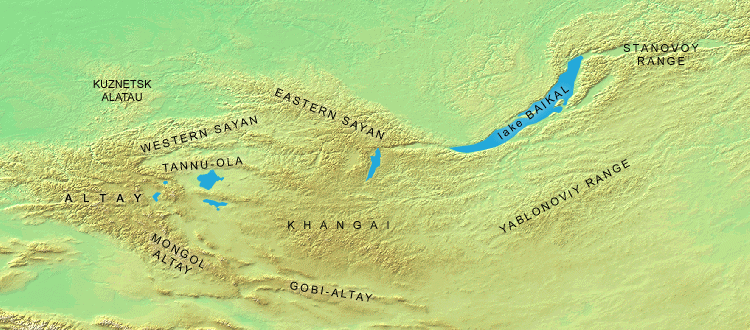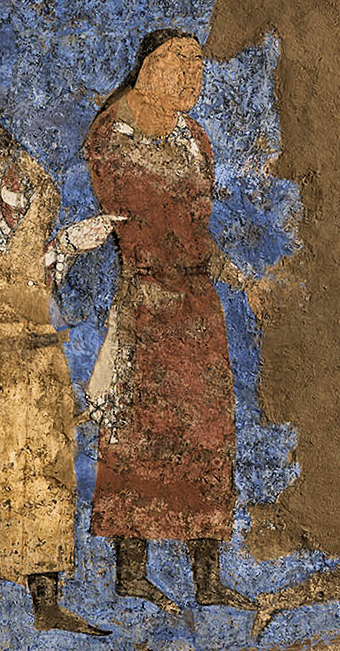|
Emperor Taizong's Campaign Against Xueyantuo
The Emperor Taizong of Tang (r. 626—649), the second emperor of the Tang dynasty, early in his reign, had allied with Xueyantuo, a vassal of the powerful Eastern Tujue ( Göktürk) Khanate, against Eastern Tujue, who Tang defeated in 630. Upon Eastern Tujue's defeat, Xueyantuo's Zhenzhu Khan Yi'nan took over Eastern Tujue's former territory, and while he was formally submissive to Tang, he was expanding his own strength. When Emperor Taizong tried to restore Eastern Tujue in 639 under the Qilibi Khan Ashina Simo (also known as Li Simo) to counteract the rise of Xueyantuo power, Xueyantuo engaged in multiple battles with the newly restored Eastern Tujue, in order to prevent this return. The major Tang general Li Shiji temporarily came to protect Eastern Tujue against Xueyantuo and defeated the Xueyantuo forces in 641. But in 644, with Emperor Taizong occupied with a campaign against Goguryeo, Xueyantuo forces launched a new campaign, defeated Eastern Tujue, forcing Ashina Simo to ... [...More Info...] [...Related Items...] OR: [Wikipedia] [Google] [Baidu] |
Geography Of Mongolia
Mongolia is a landlocked country in Central Asia and East Asia, located between China and Russia. The terrain is one of mountains and rolling plateaus, with a high degree of relief. The total land area of Mongolia is 1,564,116 square kilometres. Overall, the land slopes from the high Altai Mountains of the west and the north to plains and depressions in the east and the south. The Khüiten Peak in extreme western Mongolia on the Chinese border is the highest point (). The lowest point is at , is the Hoh Nuur or lake Huh. The country has an average elevation of . The landscape includes one of Asia's largest freshwater lakes (Lake Khövsgöl), many salt lakes, marshes, sand dunes, rolling grasslands, alpine forests, and permanent mountain glaciers. Northern and western Mongolia are seismically active zones, with frequent earthquakes and many hot springs and extinct volcanoes. The nation's closest point to any ocean is approximately from the country's easternmost tip, bordering Nor ... [...More Info...] [...Related Items...] OR: [Wikipedia] [Google] [Baidu] |
Qilibi Khan
Qilibi Khan (Chinese: 俟力苾可汗, (Pinyin): qílìbì kěhàn, ( Wade-Giles): ch'i-li-pi k'o-han, Middle Chinese: (Guangyun) , died 647), personal name Ashina Simo (阿史那思摩), Chinese name Li Simo (李思摩), full regal title Yiminishuqilibi Khagan (乙彌泥孰俟力苾可汗), Tang noble title Prince of Huaihua (懷化王), was a member of the Eastern Tujue (Göktürk) royal house who was given the title of Khan of Eastern Tujue for several years, as a vassal of the Chinese Tang Dynasty. Background After Emperor Taizong of Tang conquered Eastern Tujue in 630, he briefly settled the Eastern Tujue people within Tang borders, but after a failed assassination attempt against him by a member of the Eastern Tujue royal house, Ashina Jiesheshuai in 639, he changed his mind and decided to resettle the Eastern Tujue people between the Great Wall and the Gobi Desert, to serve as a buffer between Tang and Xueyantuo. He created Ashina Simo, a member of Eastern Tujue's royal ho ... [...More Info...] [...Related Items...] OR: [Wikipedia] [Google] [Baidu] |
Khan (title)
Khan ''khan/qan''; tr, han; Azerbaijani: ''xan''; Ottoman: ''han''; Old Turkic: ''kan''; Chinese: 汗 ''hán''; Goguryeo: 皆 ''key''; Buyeo: 加 ''ka''; Silla: 干 ''kan''; Gaya: 旱 ''kan''; Baekje: 瑕 ''ke''; Manchu: ; Persian: خان; Punjabi: ਖ਼ਾਨ; Hindustani: ख़ान or ख़ां (Devanagari), or (Nastaleeq); Balochi: خان; Bulgarian: хан, ''khan''; Chuvash: хун, ''hun''; Arabic: خان; bn, খান or ) () is a historic Turko-Mongol title originating among nomadic tribes in the Central and Eastern Eurasian Steppe to refer to a chief or ruler. It first appears among the Rouran and then the Göktürks as a variant of khagan (sovereign, emperor) and implied a subordinate ruler. In the Seljuk Empire, it was the highest noble title, ranking above malik (king) and emir (prince). In the Mongol Empire it signified the ruler of a horde (''ulus''), while the ruler of all the Mongols was the khagan or great khan. The title subsequently de ... [...More Info...] [...Related Items...] OR: [Wikipedia] [Google] [Baidu] |
Ashina Yugu
{{disambig, surname ...
Ashina may refer to: *Ashina tribe, a ruling dynasty of the Turkic Khaganate *Ashina clan (Japan),_one_of_the_Japanese_clans *Ashina_District,_Hiroshima.html" ;"title="DF 7 of 80; retrieved 2013-5-4 ..., one of the Japanese clans *Ashina District, Hiroshima">DF 7 of 80; retrieved 2013-5-4 ..., one of the Japanese clans *Ashina District, Hiroshima, a former Japanese district *Empress Ashina (551–582), empress of the Chinese/Xianbei dynasty Northern Zhou *Sei Ashina (1983–2020), Japanese actress *Main setting of ''Sekiro: Shadows Die Twice'' See also *[ sena, a mythical female wolf found in old Turkic mythology *Ashna (other) Ashna may refer to: Surname * Hesamodin Ashna, Iranian politician presidential advisor * Hossein Ashena, Iranian footballer. Given name * Ashna Zaveri Ashna Zaveri is an Indian actress and model who acts in Tamil films. Career She made he ... [...More Info...] [...Related Items...] OR: [Wikipedia] [Google] [Baidu] |
Jiali Khan
Illig Qaghan (Old Turkic: ; ), born Ashina Duobi (), posthumous name Prince Huang of Guiyi (歸義荒王), was the last qaghan of the Eastern Turkic Khaganate. Background He was a son of Yami Qaghan and his Tuyuhun wife Poshi (婆施). He was raised by the Tuyuhun general Külüg Tarkhan (胡祿達官). After coming of age, he was given the title Baghatur shad (莫賀咄設) and was assigned to rule the eastern parts of the empire. Reign He declared himself Illig Khagan after the death of his older brother Chuluo and married his brother's widow as well. He gave his nephew Ashina Shibobi the title of Tolis Qaghan afterwards and assigning him to his own former tribes. He continued his predecessors' pro-Sui politics, supporting puppet emperors. Raids into Tang His first contacts with Tang were very hostile. In 621, Tujue forces attacked Fenyin and Xi territories, reaching as south as Yanmen in April. As a response, Turkic ambassadors were arrested in China and vice versa. ... [...More Info...] [...Related Items...] OR: [Wikipedia] [Google] [Baidu] |
Yiedie Khan
Yiedie Khan (也咥可汗), personal name Yishibo (乙失缽),Regarding the dispute about the surname of Xueyantuo khans, see Xueyantuo. was a seventh-century Turkic political leader of the Xueyantuo, the first to have taken the title of Khan (title), khan. At the time of Yishibo's rule over the Xueyantuo, the Xueyantuo were a part of the Dingling, Chile confederation, made of 15 tribes, which at the time submitted to Western Tujue's Heshana Khan Ashina Daman (r. 603-611). Ashina Daman was said to be collecting excessive taxes from the Chile, leading to resentment among the Chile. Ashina Daman thus suspected the Chile chieftains and, on one occasion, gathered some 100 Chile chieftains and slaughtered them. The Chile thereafter rebelled and supported Geleng (歌楞), the chieftain of the Qibi tribe, Qibi (契苾), as the Yiwuzhenmohe Qaghan, Yiwuzhenmohe Khan (易勿真莫賀可汗). They also supported Yishibo as Yiedie Khan, as a subordinate khan under Geleng. Later, after West ... [...More Info...] [...Related Items...] OR: [Wikipedia] [Google] [Baidu] |
Heshana Khan
Heshana Qaghan or Heshana Khagan (Chinese: 曷娑那可汗, (Pinyin): hésuōnà kěhàn, ( Wade-Giles): ho-so-na k'o-han, Middle Chinese ( Guangyun) or 曷薩那可汗/曷萨那可汗, hésànà kěhàn, ho-sa-na k'o-han; at one point known as Chuluo Kehan (處羅可汗/处罗可汗) and Nijue Chuluo Khagan (泥厥處羅可汗/泥厥处罗可汗), personal name Ashina Daman (阿史那達漫/阿史那达漫, āshǐnà dámàn, a-shih-na ta-man) - was the second khagan of the Western Turkic Khaganate. He was the son of Niri Qaghan. He appeared as ''Čôl χâɣân'' in The Provincial Capitals of Iran. Reign Not much is known about his reign. He appointed lesser khagans. He was said to be collecting excessive taxes from the Tiele, leading to resentment among the tribes of the Tiele. Khagan thus suspected the Tiele chieftains and, on one occasion, gathered some 100 Tiele chieftains and slaughtered them. Tiele thereafter rebelled and supported Geleng (歌楞), the chieftain of t ... [...More Info...] [...Related Items...] OR: [Wikipedia] [Google] [Baidu] |
Eastern Tujue
The Eastern Turkic Khaganate () was a Turkic khaganate formed as a result of the internecine wars in the beginning of the 7th century (AD 581–603) after the First Turkic Khaganate (founded in the 6th century in the Mongolian Plateau by the Ashina clan) had splintered into two polities – one in the east and the other in the west. Finally, the Eastern Turkic Khaganate was defeated and absorbed by the Tang dynasty, and Xueyantuo occupied the territory of the former Turkic Khaganate. History Outline In 552-555 the Göktürks replaced the Rouran Khaganate as the dominant power on the Mongolian Plateau, forming the First Turkic Khaganate (552-630). They quickly spread west to the Caspian Sea. Between 581 and 603 the Western Turkic Khaganate in Central Asia separated from the Eastern Khaganate in the Mongolian Plateau. In the early period the Central Plain regimes were weak and paid tribute to the Turks at times. The Tang dynasty eventually overthrew the Eastern Turks in 6 ... [...More Info...] [...Related Items...] OR: [Wikipedia] [Google] [Baidu] |
Western Tujue
The Western Turkic Khaganate () or Onoq Khaganate ( otk, 𐰆𐰣:𐰸:𐰉𐰆𐰑𐰣, On oq budun, Ten arrow people) was a Turkic khaganate in Eurasia, formed as a result of the wars in the beginning of the 7th century (593–603 CE) after the split of the Turkic Khaganate (founded in the 6th century on the Mongolian Plateau by the Ashina clan) into a western and an eastern Khaganate. The whole confederation was called ''Onoq'', meaning "ten arrows". According to a Chinese source, the Western Turks were organized into ten divisions. The khaganate's capitals were Navekat (summer capital) and Suyab (principal capital), both situated in the Chui River valley of Kyrgyzstan, to the east of Bishkek. Tong Yabgu's summer capital was near Tashkent and his winter capital Suyab. The Western Turkic Khaganate was subjugated by the Tang dynasty in 657 and continued as its vassal until their collapse. History The first Turkic Khaganate was founded by Bumin in 552 on the Mongolian Plate ... [...More Info...] [...Related Items...] OR: [Wikipedia] [Google] [Baidu] |
Dingling
The Dingling ( (174 BCE); (200 BCE); Eastern Han Chinese: *''teŋ-leŋ'' < : *''têŋ-rêŋ'') were ancient people who lived in , mentioned in Chinese historiography in the context of the 1st century BCE. They are assumed to have been related to and speakers, to be early Proto- |
Yitewushi Khan
Yitewushi Khan (伊特勿失可汗), personal name Duomozhi (咄摩支), was the last khan of Xueyantuo. Little is known about Duomozhi's background, other than that he was a nephew of Xueyantuo's greatest khan, the Zhenzhu Khan Yi'nan. In 646, during the reign of Yi'nan's son and successor, the Duomi Khan Bazhuo, Xueyantuo fell into a state of confusion due to a combination of attacks by the Tang dynasty, misrule by Bazhuo, and rebellions by the Huige. Bazhuo was killed in a Huige attack, and Xueyantuo forces collapsed. Some 70,000 people fled west and supported Duomozhi as the Yitewushi Khan. Under Duomozhi, they returned east to their old territory, but, with Huige having taken much of the old Xueyantuo territory, Duomozhi soon renounced the title of khan, sending an emissary to Tang to request permission to move to the area north of the Khangai Mountains. Emperor Taizong of Tang initially sent the official Cui Dunli to try to comfort Duomozhi, but at the same time was concerned ... [...More Info...] [...Related Items...] OR: [Wikipedia] [Google] [Baidu] |






